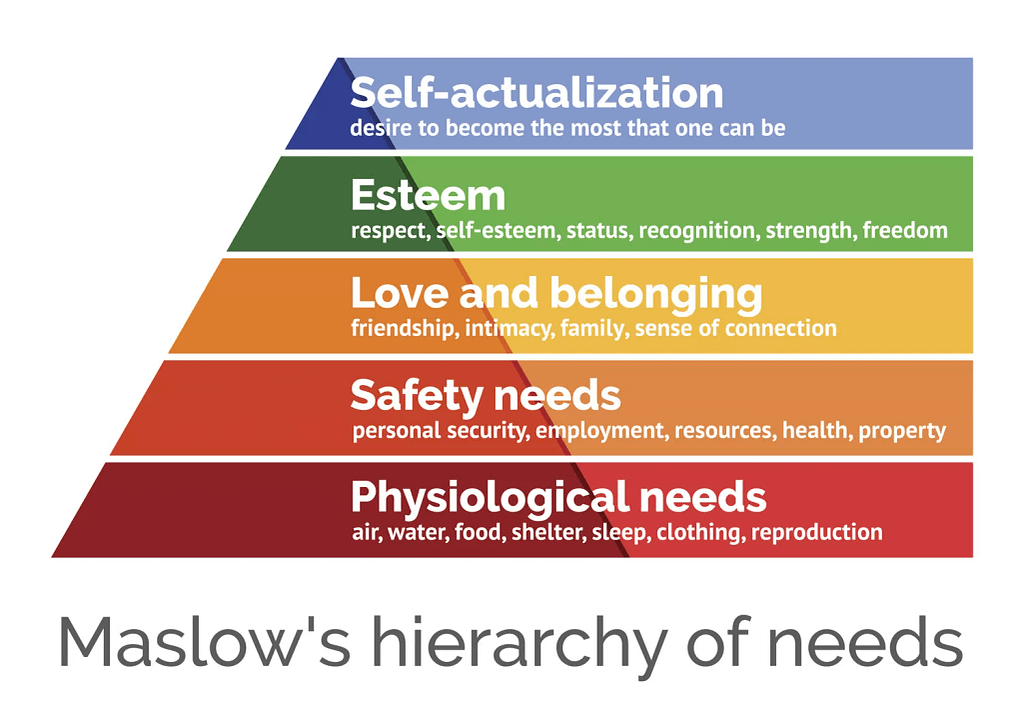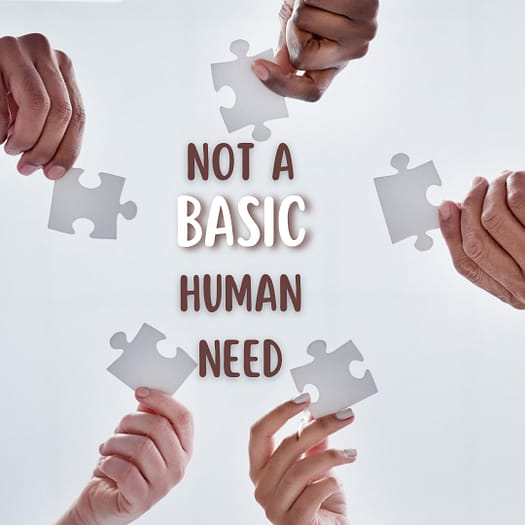Have you ever paused to consider what qualifies as a basic human need? While we often hear about essentials like food, water, and shelter, there’s a broader spectrum to explore, especially in the context of our modern lifestyle. This intriguing question, “Which of the following in not a basic human need?” leads us down a path of self-discovery and understanding.
Abraham Maslow, a renowned psychologist, introduced the concept of basic human needs through his famous Maslow’s Hierarchy of Needs. This pyramid-like structure starts with physiological needs at the base, followed by safety, love and belonging, esteem, and self-actualization at the top. Each level represents a set of needs that, according to Maslow, must be satisfied before moving to the next.

But here’s where it gets interesting. In today’s fashion-forward and health-conscious world, how do these needs translate? Does our pursuit of the latest trends or wellness routines align with these fundamental needs, or are they a reflection of something beyond Maslow’s framework? Understanding these needs isn’t just about survival; it’s about thriving in every aspect of life, including fashion, relationships, and personal well-being.
Keep this question in mind: Which of the following in not a basic human need? The answer might surprise you and change the way you view your daily choices and lifestyle.
Table of Contents
Understanding Basic Human Needs
When we ask ourselves, Which of the following in not a basic human need? it’s crucial to first understand what these needs truly are. Fundamentally, basic human needs encompass what we require to survive and maintain well-being: food, water, shelter, and clothing. These elements are not just physical necessities but are also deeply intertwined with our emotional and psychological health.
Food and water, for instance, are the fuel our bodies need to function. Without adequate nutrition and hydration, our health deteriorates, affecting all aspects of our life. Shelter provides us with a safe space, protecting us from environmental elements and giving us a sense of security and belonging. Clothing, too, is not just about covering our bodies; it’s about protection, expression, and, in many cultures, a reflection of identity.
But how do these needs fit into our contemporary world? This is where Abraham Maslow’s Hierarchy of Needs becomes relevant. While the foundation of this pyramid addresses these basic physical needs, it goes beyond to include psychological and self-fulfillment needs, which are equally crucial in today’s fast-paced, emotionally complex society. It challenges us to think beyond the surface and consider the emotional and psychological aspects of what we need as humans.
As we explore the idea of “Which of the following in not a basic human need?” we begin to understand that the answer isn’t just about physical survival. It’s about the totality of human experience, encompassing both our material and emotional worlds. This understanding is crucial in our journey towards not just living, but thriving.
The Fashion and Lifestyle Perspective
As question arises, Which of the following in not a basic human need? it becomes fascinating to explore how these needs influence our fashion and lifestyle choices. Clothing, as a basic need, has evolved far beyond its original purpose of protection. It now serves as a canvas for personal expression, a statement of identity, and even a status symbol.
Take the fashion industry, for instance. It’s not just about covering our bodies anymore. Fashion is a way to communicate who we are, what we believe in, and where we belong in society. This evolution from a basic need to a complex cultural phenomenon prompts us to ask again, Which of the following in not a basic human need? In the realm of fashion, the line between need and desire becomes intriguingly blurred.
Similarly, the concept of shelter transcends the mere idea of physical protection. Today, our homes are extensions of our personalities, adorned with decor that reflects our tastes, experiences, and aspirations. When we ask, Which of the following in not a basic human need? in the context of home decor, it challenges us to think about how our living spaces contribute to our sense of self and emotional well-being.
While clothing and shelter remain basic human needs, the way we approach fashion and lifestyle today adds layers of complexity and meaning. These choices, influenced by a multitude of factors, signify more than just survival; they represent our journey towards self-expression and identity formation.
The Non-Essentials: Which of the following in not a basic human need?
In our quest to answer the question, Which of the following in not a basic human need? we encounter a fascinating intersection between need and luxury. Today’s society often blurs these lines, leading to some intriguing misconceptions.
Let’s consider private cars. While transportation is essential, owning a private car is not a fundamental human need but a luxury. The ability to move from one place to another is crucial, but the method of transportation can vary greatly. This distinction prompts us to revisit our core question: Which of the following in not a basic human need? The answer becomes clear when we differentiate between the need for mobility and the luxury of private vehicle ownership.
Similarly, the internet, while increasingly integral to our daily lives, falls into a gray area. Is it a basic need or a luxury? With the digital era’s expansion, the internet has become almost indispensable for communication, work, and access to information. However, when we ask, Which of the following in not a basic human need? we must acknowledge that the internet, despite its vast importance, is not a fundamental necessity for human survival, but rather a powerful tool that enhances our quality of life.
[Insert an infographic contrasting basic needs like food, water, and shelter with modern luxuries such as private cars, high-end technology, and luxurious home decor]
It’s crucial to back these insights with reliable sources. For instance, a study by National Library of Medicine highlights the differentiation between essential needs and modern luxuries, providing a clearer understanding of what constitutes our basic necessities.
In summary, while items like private cars and the internet greatly impact our lifestyle and efficiency, they are not basic human needs. This realization helps us appreciate the fine line between what we need to live and what enhances our living, reiterating the importance of understanding the essence of the question, Which of the following in not a basic human need?
Beyond the Basics – The Higher Levels of Maslow’s Pyramid
Moving beyond the question, Which of the following in not a basic human need? let’s explore the higher levels of Maslow’s hierarchy: safety, love/belonging, esteem, and self-actualization. These levels transcend basic survival and delve into psychological and emotional well-being.
Safety extends beyond physical safety to include financial security and health. It’s about creating a stable environment where one can thrive without fear. For instance, the choice of a secure and well-located home is not just a preference but a step towards fulfilling this need.
Love and belonging, the third tier, revolve around relationships and connections. It’s not just about romantic relationships but also friendships, family bonds, and a sense of community. Fashion and lifestyle choices often reflect this need, as we dress to express ourselves and fit into desired social groups.
Esteem needs involve the desire for respect, confidence, and achievement. This can be reflected in career choices, hobbies, and even the brands we associate with. A quote from psychologist Carl Rogers beautifully captures this: “The only person who is educated is the one who has learned how to learn and change.”
Lastly, self-actualization is about realizing personal potential and self-fulfilment. It’s the pursuit of personal growth, creativity, and experiences that resonate with one’s true self.
Incorporating these higher needs into our lifestyle choices signifies a journey towards a more fulfilled and purposeful life.
Integrating Basic Needs into Our Lives
Now, let’s turn our attention back to the essentials and consider how to fulfill basic needs stylishly and sustainably. Understanding Which of the following in not a basic human need? helps us appreciate and meet our true necessities in a more meaningful way.
Fashion-wise, opting for timeless, high-quality pieces that can be mixed and matched offers both functionality and style. Sustainable fashion is not just a trend but a way to respect our environment while catering to our need for clothing.
In terms of home decor, the key is to find a balance between aesthetics and practicality. Choose decor that reflects your personal style but also serves a purpose. Functional yet stylish furniture, energy-efficient appliances, and eco-friendly materials are great choices.
To assess and meet your basic needs effectively, start by evaluating your current lifestyle. Identify areas where your needs are not being met and seek ways to address them. Remember, fulfilling these needs is the foundation upon which you can build towards higher levels of Maslow’s pyramid.
Wrap UP
As we wrap up our exploration of Which of the following in not a basic human need? it’s clear that understanding our basic needs is crucial in the context of fashion and lifestyle. It’s about finding a balance between fulfilling these needs and expressing our individuality.
I encourage you to reflect on your own needs. How do you address them in your daily life? Are your choices aligned with your true necessities, or are they influenced by societal expectations?
For more insights into personal growth and making informed choices, don’t forget to check out my previous post on “When Is a Woman in Her Prime?” It’s a read you won’t want to miss!
